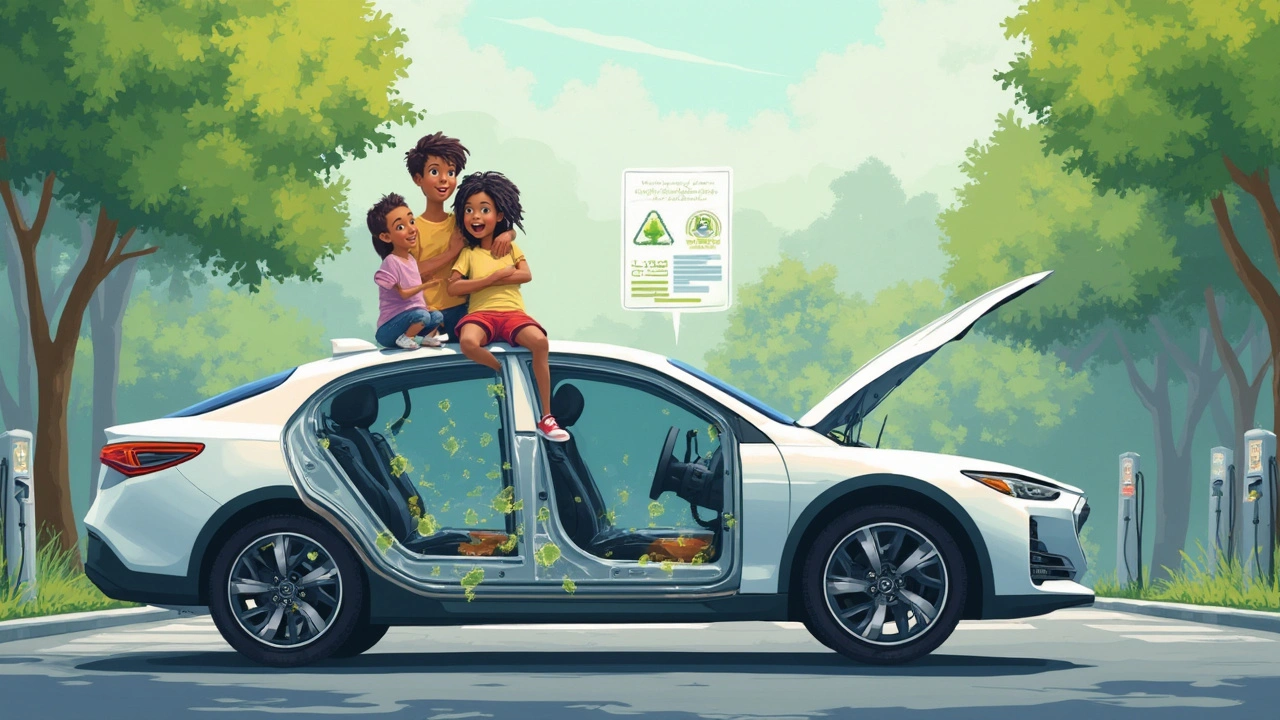Why Eco-Friendly Car Parts Matter Now More Than Ever
You might not think about what your car is made of until something breaks, or that little check engine light starts blinking. Here’s the thing: most vehicles on the road today pack in a mind-boggling mix of metals, plastics, glass, and rubber, much of which gets dumped after a car’s life is over. The stats are clear—according to the EPA, the U.S. auto industry generates millions of tons of waste annually, much of which comes from end-of-life vehicles cluttering landfills, leaking harmful chemicals, and clogging up the environment for decades. Eco-friendly car parts are changing that narrative, offering real ways to reduce waste and pollution, and lighten our footprints, no matter what you drive.
If you think eco-friendly means giving up performance or paying double for every repair, guess again. Car part manufacturers are doubling down on solutions that combine environmental smarts with top-shelf durability and reliability. We’re talking about reimagining what a car is, right down to the nuts and bolts. Cork dashboards, soy-based seat cushions, recycled aluminum engine blocks, and water-based paints are all getting road time in the latest production lines. Ford, for example, swapped out traditional plastics for soy foam in over 18 million vehicles since 2011, saving an estimated 2.5 million pounds of oil annually. That’s not just a marketing gimmick—it’s a visible shift toward sustainable car parts that benefit both people and planet.
Today's eco-friendly parts aren't just hype. They deliver real-world benefits you’ll notice, from better fuel economy to longer part life. When automakers turn to lightweight materials, your engine does less work, translating to fewer trips to the pump and less carbon kicked up into the atmosphere. Aluminum-alloy wheels made from recycled cans reduce vehicle weight and boost fuel efficiency by as much as 7%. More automakers now use recycled steel and plastics in frames and interiors, cutting emissions and manufacturing costs. Tesla, BMW, and Toyota aren’t the only players here—scrap yards and aftermarket suppliers are joining the game, recycling bumpers, windshields, and even seat belts into new parts.
But there’s a kicker—while electric vehicles and hybrids grab headlines for being ‘eco,’ they’re still filled with parts that, if not thoughtfully sourced or recycled, can cause plenty of environmental headaches down the line. The magic really happens when every component, from the alternator to the upholstery, gets the sustainable treatment. Going green on car parts doesn’t just mean feeling good; it means spending less, wasting less, and experiencing a future where our rides do more for us without costing the Earth. If you’re looking for an excuse to upgrade, now’s the time to start paying attention to your next replacement part.

The Evolution of Sustainable Mobility and Recycled Auto Parts
Sustainable mobility once conjured up images of slow-moving, compact city cars and golf carts pretending to be vehicles. Forget that. Over the last decade, things shifted big time. Now, shifting to sustainable mobility means major manufacturers are retooling everything from suspension struts to the floor mats—and not just with the planet in mind, but with performance and longevity as priorities. It’s not science fiction. In 2025, pretty much every carmaker has invested in circular economy strategies, where almost every material in a new car is tracked, reused, or repurposed. This is a far cry from noisy scrapyards with mountains of steel rusting under the sun. It’s closer to high-tech sorting centers, massive 3D printers, and advanced manufacturing algorithms cranking out parts with minimized energy and waste. Recent data from Auto Recyclers of America suggest that over 85% of end-of-life vehicle material can now be recovered for reuse. That’s a jump from about 75% just five years ago!
Why is this possible? Smart engineering, plain and simple. Take bamboo fiber, for instance—it’s not just a trendy material for kitchen cutting boards. Hyundai’s flagship models use molded bamboo composites for dashboard panels that outlast traditional plastics and break down safely if ever discarded. Or check out Nissan, which integrates old fishing nets and marine debris into floor liners for select models. When you steer with a wheel made partially of bioplastics, you’re cutting demand for the petroleum industry and keeping tons of plastic out of the ocean. Even tires are going green, with companies like Michelin and Goodyear shaping out-of-the-box formulas that reclaim up to 70% of their material from recycled rubber, rice husks, and plant-based oils.
Modern auto shops and DIY mechanics have caught on, too. Sourcing recycled auto parts is easier than ever. Several online platforms, like Car-part.com or LKQ, provide access to millions of refurbished and reclaimed components, often with warranties matching brand-new parts. Plus, many eco-friendly alternatives now come with clear eco-labels and transparent data about their carbon footprint, so you know what you’re getting. Some municipalities, including New York, offer tax incentives for shops that prioritize parts made from recycled content, giving shoppers more reason to choose green.
The switch pays off in reduced costs and increased quality as well. A 2024 report by the International Transport Forum highlighted that vehicles using >30% recycled-content parts often see a 10-12% cut in lifetime repair and maintenance expenses. Since eco-friendly parts are designed to meet (or beat) original equipment standards, you’re not sacrificing quality or warranty. Also, some insurance providers now give discounts to customers who opt for recycled fenders, remanufactured transmissions, or certified-used batteries, seeing as they reduce the overall carbon risk of insured fleets.
Traditional salvage yards are also getting a facelift. Instead of just stripping cars for whatever can be junked or sold, many now partner with tech companies to certify the parts’ origins and keep digital records of every component. So, if you snag a recycled alternator or an upcycled bumper, you can trace its entire life story, adding confidence and accountability to the sustainable car parts you choose. This digital revolution means that greener choices are no longer a gamble; they’re tracked, trusted, and easier to recommend to friends or family who want to lower their ride’s footprint.

Smart Upgrades: Practical Tips for Going Green With Your Car
Thinking about swapping standard parts for greener ones? Start simple and go for what gives the biggest payoff. First, check if replacement options for your model use recycled or renewable materials. Many OEM and aftermarket brands—think Dorman, Bosch, and Cardone—now flag their eco-friendly car parts with special tags. Don’t settle for generic plastic covers or metal trims; look for nylon fibers or composite blends that use agricultural or post-consumer waste. Carpets made from PET bottles, for example, feel just as plush and sturdy as traditional ones, but they keep thousands of bottles out of landfills for every sedan built. Subaru’s zero-landfill factory in Indiana turns scrap copper wire into fresh connectors for their new cars. That’s a closed loop system you can trust.
When it’s time to replace a battery, don’t toss the old one away. Almost all auto batteries, even from hybrids and EVs, can be disassembled and recycled. Call your local municipal waste service or check if your dealership runs a take-back program. Many states—especially in the Northeast and California—now offer rebates for returning your used battery and picking up a certified remanufactured one instead. Reman batteries work just as well as new, but with a fraction of the environmental impact. Meanwhile, swapping brake pads for copper-free or ceramic alternatives reduces toxic runoff, which is a huge win for city dwellers worried about water quality.
Pay attention to your tires, too. Eco-tires made with natural rubber, silica, and recycled polyester cut rolling resistance, saving gas or boosting an EV’s range. Michelin’s Primacy MXM4, for instance, uses sunflower oil to keep rubber supple in the winter and lasts longer than many competitors. If you’re not ready for a full replacement, consider local retreading services for fleet vehicles or family vans—reusing existing tire casings saves up to 80% of the energy needed to make a new tire.
Cleaning up your ride can be as simple as choosing eco-safe fluids and filters. Biodegradable transmission fluids, synthetic engine oils, and recycled-paper cabin filters cut the toxins that end up in water systems. Start small and work your way up: each time something wears out, see if a greener alternative is available. For major repairs, ask your mechanic about parts with Environmental Product Declarations (EPDs)—these outline exactly how a part's production, use, and end-of-life impacts play out.
Don’t overlook the power of DIY upgrades. If you’re handy with basic tools, plenty of eco-friendly mods can be made from parts found at green auto shops or certified salvage. Try swapping incandescent bulbs for LEDs—which use less energy and last many times longer—or retrofit heated seats using recycled padding and wiring from disassembled vehicles. Community repair clinics sometimes offer workshops on installing and identifying sustainable components, giving people hands-on ways to make their cars cleaner.
Wondering how all this stacks up in your budget? Here’s a quick look comparing common sustainable car upgrades vs. traditional replacements (data from the Green Auto Initiative, 2024):
| Part | Traditional Avg. Cost | Eco-Friendly Avg. Cost | Est. Energy Savings | Landfill Reduction |
|---|---|---|---|---|
| Seat Foam | $145 | $157 | 30% | 80% less waste |
| Carpet | $240 | $255 | 28% | 100+ bottles saved |
| Bumper | $390 | $350 (recycled) | 12% | Major plastics saved |
Repairing with recycled green car technology usually doesn’t break the bank and will often pay back in energy and emissions savings within a year or two. And every small choice adds up, especially when millions of drivers join the movement. So, whether you’re keeping your ride tuned up for the next weekend road trip or planning a bigger overhaul, greener car parts are within reach—and easier to get than you might think.






Adithya M
July 17, 2025 AT 22:26Honestly, I'm all for the shift to eco-friendly car parts, but some people really underestimate the challenges here. The article highlights recycled materials and biodegradable innovations, which is great, but we have to look at the actual durability and safety of these parts, right? You can't just swap out traditional components for greener ones if they fail or put drivers at risk. Plus, the costs can be a deal-breaker for many buyers, especially in countries where new tech means big price hikes.
That said, the push towards smart manufacturing processes is where I see real promise. Reducing waste and energy in factories is vital. But where are the incentives? If governments and companies don't get serious about supporting sustainable auto parts, progress will be sluggish. I'm eager to see more transparency on the lifecycle of these parts—from production to end-of-life recycling.
Does anyone have experience sourcing these green parts locally? I feel like availability is still a massive hurdle despite growing demand.
Jessica McGirt
July 20, 2025 AT 00:10This article really piqued my curiosity about where exactly I can find these sustainable car parts if I wanted to make a start. The piece touches on actionable tips, which is refreshing because so many write-ups just paint a rosy picture without practical guidance.
I appreciate that they mentioned the impact on wallets too — it’s often overlooked that going green can save money in the long run, not just the environment. Does anyone know some trusted brands or shops that specialize in biodegradable or recycled auto parts? Also, how technical do you need to get if you're just an average car owner?
These questions have been on my mind for a while, and I'd love some advice from anyone who’s taken the plunge into green mobility solutions.
Donald Sullivan
July 24, 2025 AT 06:23Look, I’m all for sustainability, but sometimes these articles too often paint it like switching to green car parts is a walk in the park. Let’s be honest, the entire auto industry is built on massive existing supply chains and infrastructure. Throwing in recycled materials and biodegradable stuff is a complex overhaul, not just an optional upgrade for eco-warriors.
What really grinds my gears is the lack of mention of the environmental costs in producing these novel parts themselves. Sometimes they require exotic materials or energy-intensive processes that aren't exactly 'green.' We need full transparency about that too, or it’s just greenwashing.
Still, the article brings up some good pointers about smart manufacturing. That’s where we might see real impact if companies get serious instead of just playing PR games.
Tina van Schelt
July 24, 2025 AT 20:16Omg, yes — the whole idea of green car parts feels so vibrant and promising! 🌿 It's like we finally get to see cars step into the future without trampling all over our planet. The description of biodegradable innovations really lights up my imagination. I picture cars that literally leave no nasty trace behind.
Also, the article’s tone is encouraging for beginners. Sometimes sustainability discussions get so technical and dry, making it tough to motivate people. This one balances passion and practicality wonderfully. I’m curious though, do you think there’s enough consumer awareness about where to look for these parts? Because unless we demand them, industry won’t put them on shelves.
It’d be great if everyone could share how they’ve promoted green mobility in their circles. Change starts with conversations like these! 🌟
Ronak Khandelwal
July 29, 2025 AT 00:00Such a fascinating topic! Eco-friendly car parts feel like a tangible step toward nurturing our planet while embracing progress. 🌍✨ I think the blending of recycled materials and smart manufacturing has this poetic synergy — turning what was once discarded into something valuable and sustainable.
We have to remember, though, that this transformation challenges long-held norms in the automotive world. It's almost like a new philosophy of mobility where responsibility and innovation dance together. I wonder how different regions and cultures interpret this movement? Are there unique green parts innovations emerging from different parts of the world?
Also, the mention of wallet impact made me smile. Sustainability isn't just about sacrifice; it can also be smart economics. The future is bright if we make conscious choices together! 🚗💚🌱
Jeff Napier
July 31, 2025 AT 12:50Before we all get too excited about recycled this and biodegradable that, have you considered what’s really going on behind the scenes? These 'eco-friendly' parts might actually be part of a big corporate PR ploy to keep us buying under the guise of 'saving the planet.' Don’t forget, big companies only shift when profits demand it.
Plus, there’s always the question of how 'green' these parts are if they require mining rare minerals or toxic chemicals in the production process. Who’s auditing this? Is there a hidden environmental toll masked by shiny marketing materials? I’m skeptical.
Still, if it truly means cleaner mobility, I hope we’re moving in the right direction. Just keep your eyes peeled, folks—they're not always telling the full story.
Sibusiso Ernest Masilela
August 2, 2025 AT 02:36Honestly, I find the entire idea somewhat naive. The automotive industry is a beast deeply rooted in outdated traditions resistant to change, and now we’re supposed to believe that a few recycled parts will suddenly save the environment? Don’t make me laugh. This sounds like another overhyped fad foisted on the masses.
That said, I won’t dismiss the merits entirely; certain innovations showing biodegradable qualities do pique my interest. But is this scalable? That’s the true test. Until then, this is just glossy propaganda for the eco-conscious elite.
People should keep a critical eye, not swallow the green pill whole. The devil is in the details, and too many are swept under the rug.
Daniel Kennedy
August 4, 2025 AT 06:33Hey folks, interesting thread here! I just want to highlight that while skepticism is healthy, we shouldn’t let it paralyze us. The automotive transition to sustainable parts is gradual, complicated, and imperfect—but that doesn’t mean it’s not real progress.
From my experience as someone helping workshops integrate these parts, it’s clear that consumer education is crucial. Many drivers don’t realize how much impact they can have simply by choosing greener components. Even small choices add up when millions participate.
The article rightly notes wallet impacts too. It’s about balancing upfront costs with long term savings and environmental benefits. Has anyone tried retrofitting with biodegradable or recycled parts? Sharing real stories helps us understand the hurdles and triumphs better.
Taylor Hayes
August 10, 2025 AT 07:00Thanks for sharing this article! It’s enlightening to see such a hopeful perspective on sustainability within the car industry. I think sometimes we forget that even incremental improvements—like swapping traditional parts with eco-friendly versions—are meaningful.
However, I do share some concerns raised about availability and genuine green credentials of some parts. It’s essential that buyers research thoroughly and demand detailed information about production and recyclability.
I also love the optimistic view about how these changes could, eventually, be both easy on the planet and the budget. I hope more people embrace green mobility—it’s where our future lies.
Sanjay Mittal
August 15, 2025 AT 23:56I appreciate all the viewpoints here. From a technical standpoint, advances in materials science have been substantial in creating more durable recycled and biodegradable car parts. For example, certain bio-based polymers now match the performance of traditional plastics used in automotive applications.
Yet, practical implementation does face barriers like supply chain adjustments and cost. I encourage enthusiasts interested in green mobility to seek out reputable suppliers who provide certifications and lifecycle analysis for their products.
One key takeaway from the article is that sustainable mobility isn’t just a niche anymore—it’s gaining enough traction to influence industry trends globally. We should remain optimistic while staying informed and critical.